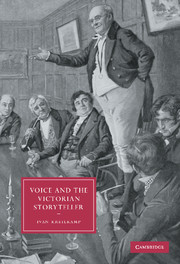Book contents
- Frontmatter
- Contents
- Acknowledgments
- 1 “The best man of all”: mythologies of the storyteller
- 2 When good speech acts go bad: the voice of industrial fiction
- 3 Speech on paper: Charles Dickens, Victorian phonography, and the reform of writing
- 4 “Done to death”: Dickens and the author's voice
- 5 Unuttered: withheld speech in Jane Eyre and Villette
- 6 “Hell's masterpiece of print”: voice, face, and print in The Ring and the Book
- 7 A voice without a body: the phonographic logic of Heart of Darkness
- Notes
- Bibliography
- Index
- CAMBRIDGE STUDIES IN NINETEENTH-CENTURY LITERATURE AND CULTURE
7 - A voice without a body: the phonographic logic of Heart of Darkness
Published online by Cambridge University Press: 22 September 2009
- Frontmatter
- Contents
- Acknowledgments
- 1 “The best man of all”: mythologies of the storyteller
- 2 When good speech acts go bad: the voice of industrial fiction
- 3 Speech on paper: Charles Dickens, Victorian phonography, and the reform of writing
- 4 “Done to death”: Dickens and the author's voice
- 5 Unuttered: withheld speech in Jane Eyre and Villette
- 6 “Hell's masterpiece of print”: voice, face, and print in The Ring and the Book
- 7 A voice without a body: the phonographic logic of Heart of Darkness
- Notes
- Bibliography
- Index
- CAMBRIDGE STUDIES IN NINETEENTH-CENTURY LITERATURE AND CULTURE
Summary
As Leopold Bloom muses to himself, there's nothing quite like the phonograph (or gramophone or graphophone, to name a couple of the competitors that followed Thomas Edison's 1877 invention) to keep alive the memory and voice of those dear departed:
Besides how could you remember everybody? Eyes, walk, voice. Well, the voice, yes: gramophone. Have a gramophone in every grave or keep it in the house. After dinner on a Sunday. Put on poor old greatgrandfather Kraahraark! Hellohellohello amawfullyglad kraark awfullygladaseeragain hellohelloamarawf kopthsth. Remind you of the voice like the photograph reminds you of the face. Otherwise you couldn't remember the face after fifteen years, say.
(Joyce, Ulysses, p. 114)“Eyes, walk, voice”: James Joyce enumerates those quintessentially modern fragments – snapshots, recordings of voice – which are taken to stand for the whole of a person. By the time radio had made the technological reproduction of voice relatively familiar, a line like T. S. Eliot's “she smooths her hair with automatic hand, / And puts a record on the gramophone” (Eliot, “The Waste Land,” lines 255–6) would suggest that a certain logic of modernity as governed by mechanical reproduction was already there for the taking in the culture. But in 1898, when Joseph Conrad began work on the novel which would provide the original epigraph for Eliot's The Waste Land (1922), the possibilities of a voice amplified and multiplied by technological means were newly available for exploration.
- Type
- Chapter
- Information
- Voice and the Victorian Storyteller , pp. 179 - 205Publisher: Cambridge University PressPrint publication year: 2005

